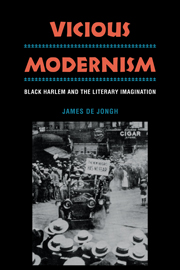Book contents
- Frontmatter
- Contents
- Acknowledgments
- Introduction: Vicious Modernism
- I The Legendary Capital: The 1920s and 1930s
- II The Emerging Ghetto: The 1940s and 1950s
- 5 The Emerging Ghetto
- 6 Go Tell It on the Mountain
- 7 Montage of a Dream Deferred
- 8 Negro de todo o mundo
- III The Inner City: The 1960s and 1970s
- Epilogue: Black Harlem and the Literary Imagination
- Appendix 1 A Checklist of Black Harlem in Poetry
- Appendix 2 A Checklist of Black Harlem in Novels
- Notes
- Index
7 - Montage of a Dream Deferred
Published online by Cambridge University Press: 05 February 2012
- Frontmatter
- Contents
- Acknowledgments
- Introduction: Vicious Modernism
- I The Legendary Capital: The 1920s and 1930s
- II The Emerging Ghetto: The 1940s and 1950s
- 5 The Emerging Ghetto
- 6 Go Tell It on the Mountain
- 7 Montage of a Dream Deferred
- 8 Negro de todo o mundo
- III The Inner City: The 1960s and 1970s
- Epilogue: Black Harlem and the Literary Imagination
- Appendix 1 A Checklist of Black Harlem in Poetry
- Appendix 2 A Checklist of Black Harlem in Novels
- Notes
- Index
Summary
The implications of the depression years and the epoch of global war for the Harlem motif were only slowly digested and assimilated in poetry. Indeed, for a time in the late 1930s and early 1940s, few poets seemed able to sing about Harlem, re-weaving the actuality of this new black ghetto into the earlier song of the culture capital. Melvin B. Tolson's was the single new voice to attempt to rise to the theme of Harlem between the riots of 1935 and 1943, but his Gallery of Harlem Portraits, completed in the late 1930s, remained unpublished in Tolson's lifetime. Robert Hayden and Gwendolyn Brooks, the major Afro-American poets to emerge in the 1940s, seem never to have employed the motif, and Margaret Walker referred to Harlem only fleetingly in “For My People.” It was left to Langston Hughes – more than any other figure shaping and elaborating the theme of Harlem in this new phase – to take the lead in confronting in poetry the fact that the city of refuge, associated initially with optimism, success, and racial amplitude, had deteriorated so rapidly into a setting for ghetto riots.
Shakespeare in Harlem (1942) – the first major poetry volume about Harlem that Hughes published after spending nearly a decade away from the enclave – identifies the Harlem environs as a landscape of jazz and blues, as had his Harlem poetry of the New Negro period, but the texture and flavor were very different.
- Type
- Chapter
- Information
- Vicious ModernismBlack Harlem and the Literary Imagination, pp. 100 - 113Publisher: Cambridge University PressPrint publication year: 1990



